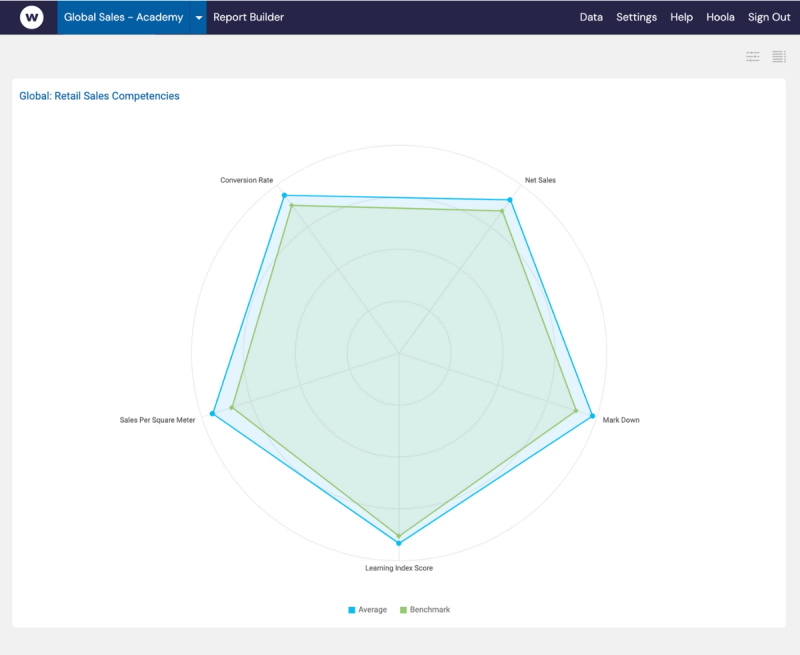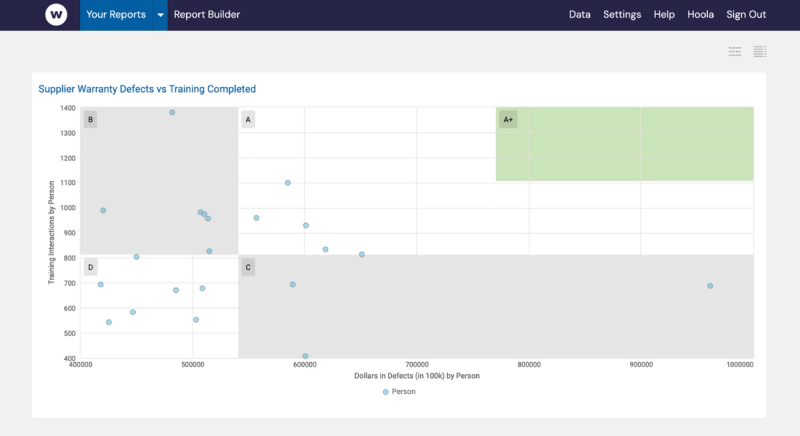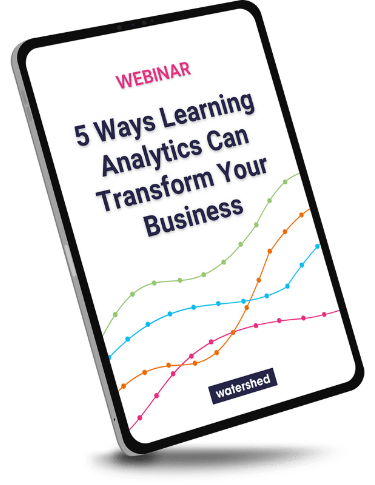It’s no secret that sales teams continually look for ways to improve performance and achieve greater success. After all, sales power an organization’s ability to stay in business. And one incredibly powerful tool that can help them do just that is learning analytics.
By using L&D data and analytics, sales teams can gain valuable insights into their team's behavior, identify areas for improvement, and make data-driven decisions to optimize their training and workforce strategy.
This two-part blog post explains how the sales team can benefit from using L&D data. We’ll dive into the practical applications and benefits of incorporating learning analytics in a sales context with real-life examples and case studies. And the second post will cover how you can integrate learning data with reporting tools and the benefits of automating sales training reports.
How L&D data and analytics can empower your sales team
One of the core challenges L&D face is linking training to business results. Sales training can be a great area to start, as sales KPIs can be more tangible than other areas of the business.
Whether you focus on pipeline movements, number of meetings/demos, or net sale increases in certain products or offerings, aligning sales KPIs with your training programs can help demonstrate that sales training programs can drive tangible business outcomes.
Here’s how L&D data can help unlock your sales team’s potential with data-driven insights:
- Impact on sales KPIs. Sales training directly influences core KPIs such as revenue and pipeline progress. By using learning analytics, you can track and measure the impact of sales training programs on these critical KPIs.
- Drive sales team behavior changes. By tracking learner activity and engagement, sales leaders gain a deeper understanding of how training impacts sales behaviors and KPIs—which means they can drive positive behavior changes and optimize training strategies based on real-time insights.
- Spot outliers: Overachievers & underachievers. Identify outliers within the sales team who excel or fall short of expectations, allowing for targeted support and training to address specific needs.
- Measure and assess extended enterprise training. Gain insights into learning’s impact on sales behaviors and KPIs across the extended enterprise. And from there, you can optimize training strategies for internal sales teams and external partners.
- Empower sales leaders with automated reports. Use learning data with existing reporting tools to automate reports for sales leaders, providing insights into their team’s performance and training impact.
- Integrate with existing reporting tools. You can quickly analyze learning and sales performance data by integrating L&D data with existing reporting tools, such as Power BI.
How does sales training impact KPIs?
We all know that sales training effectiveness is often measured by its impact on key performance indicators (KPIs) such as revenue and pipeline progress. With learning analytics, sales teams can easily track how training programs influence these critical KPIs.
You can also identify areas where employees may need additional skills or knowledge and design targeted sales training programs that address these gaps and, ultimately, improve those metrics.
For example, a financial services company combined learning data with business KPI data to drive an increased focus in “bundle” selling. After analyzing the data, they realized the most successful individuals specialized in “bundle selling” services.
As a result, they focused on upskilling and training others to focus on bundle selling. The subsequent upturn in sales helped demonstrate the successful correlation between the training program and increased sales.
Drive positive changes in sales team behavior with learning analytics
Learning analytics goes beyond just measuring training effectiveness. It can provide valuable insights into how training content influences sales team behavior and organizational metrics. For instance, some sales team behaviors that you might want to track using learning analytics include:
- Sales performance metrics. Track KPIs such as sales revenue, average deal size, conversion rates, and sales cycle length to measure training programs' effectiveness and identify areas for improvement.
- Product knowledge and expertise. Monitor the level of product knowledge and expertise among sales team members to ensure they can accurately communicate the value of your products or services.
- Customer engagement and relationship building. Analyze customer interactions, follow-up activities, and relationship-building efforts to assess training's impact on building strong customer relationships and increasing customer satisfaction.
- Sales process adherence. Evaluate adherence to the sales process—including lead qualification, pipeline management, and closing techniques—to identify areas where additional training or support may be needed.
- Use of sales tools and tech: Track the use and proficiency of sales tools, CRM systems, and other technology to ensure team members maximize the benefits of available resources.
In other words, sales leaders gain a deeper understanding of how training impacts sales behaviors and KPIs. And sales teams can use this data to drive positive behavior changes and continuously optimize their training strategies based on real-time insights.
Identify and address sales skills gaps with L&D data
One of the most powerful benefits of learning analytics is identifying skill gaps within the sales team. Using assessment tools and learning analytics platforms, you can easily monitor and pinpoint areas where sales team members lack knowledge or skills.
From there, sales leaders can implement targeted training programs to address these gaps and boost sales performance.
See Visa’s award-winning sales training and performance program increased business development opportunities.
Let’s consider a real-life example: A pharmaceutical company’s L&D department used Watershed to support a quiz game on a mobile learning platform. Watershed provided leaderboards for teams of sales reps in different territories to compete for the highest scores.
The game identified knowledge gaps after an in-person training event. By analyzing the questions with the most incorrect answers, the team identified a lack of knowledge around the company’s segmentation strategy and implemented further training to address the gap.
Spot outliers, elevate sales performance
Here are a few ways learning analytics can help spot outliers and drive positive change:
- Pinpoint overachievers. Identify sales team members who consistently exceed performance expectations. By analyzing their learning activities, you can pinpoint the behaviors, skills, and approaches contributing to their success. You can use this insight to develop best practices and training materials for the entire team.
- Identify underachievers. Analyze performance metrics, learning activities, and skill development to identify underperforming sales team members. Managers can pinpoint areas where additional support and training are needed by tracking key indicators such as low sales numbers, limited product knowledge, or inadequate customer engagement.
- Build communities of practice and innovation. Once you’ve found your outliers, you can create resources and communities that allow high-performing sales team members to share their expertise, strategies, and success stories with their peers. This practice also helps foster collaboration and innovation by creating a platform for open communication and idea sharing.
See how to use the Brinkerhoff Success Case Method to spot outliers in your sales training.
Give your sales team actionable insights with learning analytics
Learning analytics can significantly enhance sales teams’ performance. By tracking the impact of training on KPIs, identifying skill gaps, and empowering sales leaders with actionable insights, you can help drive positive changes in sales behavior and improve your workforce strategy.
Stay tuned for the second part of this blog post, which explains how you can integrate L&D data with your existing reporting tools and automate sales training reports to boost performance and strategy.
About the author
Working directly in the L&D space during the last 15 years, Craig has honed his expertise in selling SaaS solutions, driving client relationships, and providing customer service and support. And with a background in business management and specific to L&D software solutions, he’s well-versed in creating lasting partnerships in corporate and academic environments.
Subscribe to our blog




